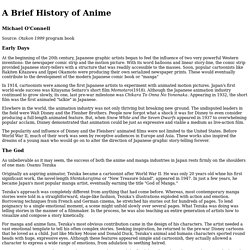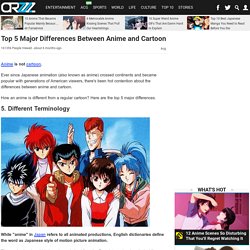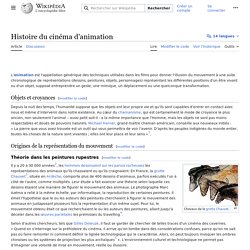

The anime production line. I was asked to talk about the hierarchy of anime production, so here is a very basic explanation of some of the key steps in anime production.

As a way of outlining the basic workflow, I'll give a brief rundown of what each of the terms that you find in anime credits entails. The terms are ordered in basic production order, from pre-production tasks to animation tasks to final assembly. I'll limit this discussion to the terms that pertain to the animation without touching on the other aspects like writing, production, art, etc., because otherwise it would take way too long to write, and I know less about those.
Please take this as what it is: the gleanings of an enthusiast. Anime Production – Detailed Guide to How Anime is Made and the Talent Behind it! I think it’s both important and fascinating to learn about the fundamentals of the medium we all love, and one of the most critical questions is: how is anime made?

For me, especially recently, that’s been a burning question that I ended up researching in detail. For the sake of other anime fans with the same question, I thought I’d share my findings. So, if you want ammunition to return fire the next time you find yourself caught in an argument about the merits of anime, or want a fresh way to look at anime, I hope this article will be useful. Over the last year or so, my increasing interest in this side of things has really opened my eyes to the talent, artistry, passion and beauty that can be found in Japanese animation. The article will focus on TV-anime production, but the same general process applies to movies and OVAs as well. The process of making an anime is a complex one, with many steps and stages. A Brief History of Anime. Michael O'Connell Source: Otakon 1999 program book Early Days At the beginning of the 20th century, Japanese graphic artists began to feel the influence of two very powerful Western inventions: the newspaper comic strip and the motion picture.

With its word balloons and linear story-line, the comic strip provided Japanese story-tellers with a structure that was readily accessible to the masses. Soon, popular cartoonists like Rakiten Kitazawa and Ippei Okamoto were producing their own serialized newspaper prints. In 1914, cartoonists were among the first Japanese artists to experiment with animated motion pictures. Elswhere in the world, the animation industry was not only thriving but breaking new ground. The popularity and influence of Disney and the Fleishers' animated films were not limited to the United States. The God As unbelievable as it may seem, the success of both the anime and manga industries in Japan rests firmly on the shoulders of one man: Osamu Tezuka From Film to TV Future.
The History of Anime and Manga. The Father of Anime & Manga Assignment How has Japanese animation evolved since World War II?

Who were the people who contributed to its change and how was it influenced by the war? Background on Art and Animation (Manga and Anime) Tofugu. Anime vs Cartoon. Differences in Visual Characteristics Anime illustrations are known to be exaggerated as far as physical features are concerned.

Usually, one can differentiate anime from a cartoon by observing the physical traits of the characters. Anime characters include "large eyes, big hair and elongated limbs" and — in the case of manga (anime comics) — "dramatically shaped speech bubbles, speed lines and onomatopoeic, exclamatory typography. "[1] Cartoons, however, approximate reality a little more and carry traces of day-to-day life in them. Facial Expressions Facial expressions for anime characters are often different in form than their counterparts in western animation. What differentiates anime from regular cartoons? - Anime & Manga Stack Exchange. No matter how you look at it, an anime is a cartoon.

The main difference is that an anime is considered a Japanese style of cartoons in the West. Top 5 Major Differences Between Anime and Cartoon. Anime is not cartoon.

Ever since Japanese animation (also known as anime) crossed continents and became popular with generations of American viewers, there's been hot contention about the differences between anime and cartoon. How an anime is different from a regular cartoon? Here are the top 5 major differences. 5. Different Terminology. 20 histoire cin ma animation. Du crayon à la souris, l’histoire de l’animation. – Pixar-Planet.Fr. Si Toy Story 3 est devenu à ce jour le film d’animation le plus rentable du cinéma d’animation, il fait partie d’une longue lignée d’un genre cinématographique toujours en expansion.

Comment parler de ce genre sans mentionner l’un des plus connus : Walt Disney. Dossier p%e9dagogoqique histoire cinema animation. 1.L'histoire du dessin animé et ses techniques. Histoire du cinéma d'animation. L'animation est l'appellation générique des techniques utilisées dans les films pour donner l'illusion du mouvement à une suite chronologique de représentations (dessins, peintures, objets, personnages) représentant les différentes positions d'un être vivant ou d'un objet, supposé entreprendre un geste, une mimique, un déplacement ou une quelconque transformation.

Objets et croyances[modifier | modifier le code] Depuis la nuit des temps, l’humanité suppose que les objets ont leur propre vie et qu’ils sont capables d’entrer en contact avec nous et même d’intervenir dans notre existence. Au cœur du chamanisme, qui est certainement le mode de croyance le plus ancien, non seulement l’animal – aussi petit soit-il - a la même importance que l’homme, mais les objets ne sont pas moins respectables et doués de pouvoirs naturels. Michael Harner, grand maître chaman américain, conseille aux nouveaux initiés : « La pierre que vous avez trouvée est un outil qui vous permettra de voir l’avenir.